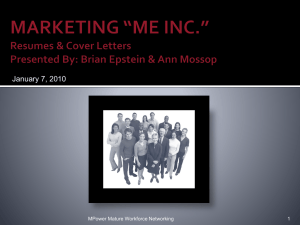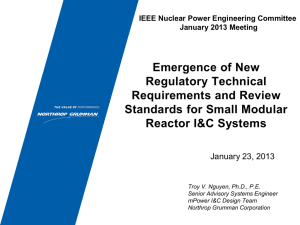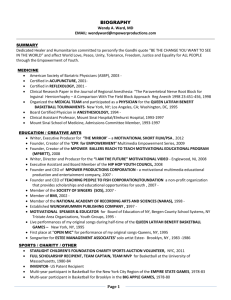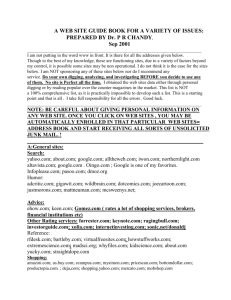Document 12961105
advertisement
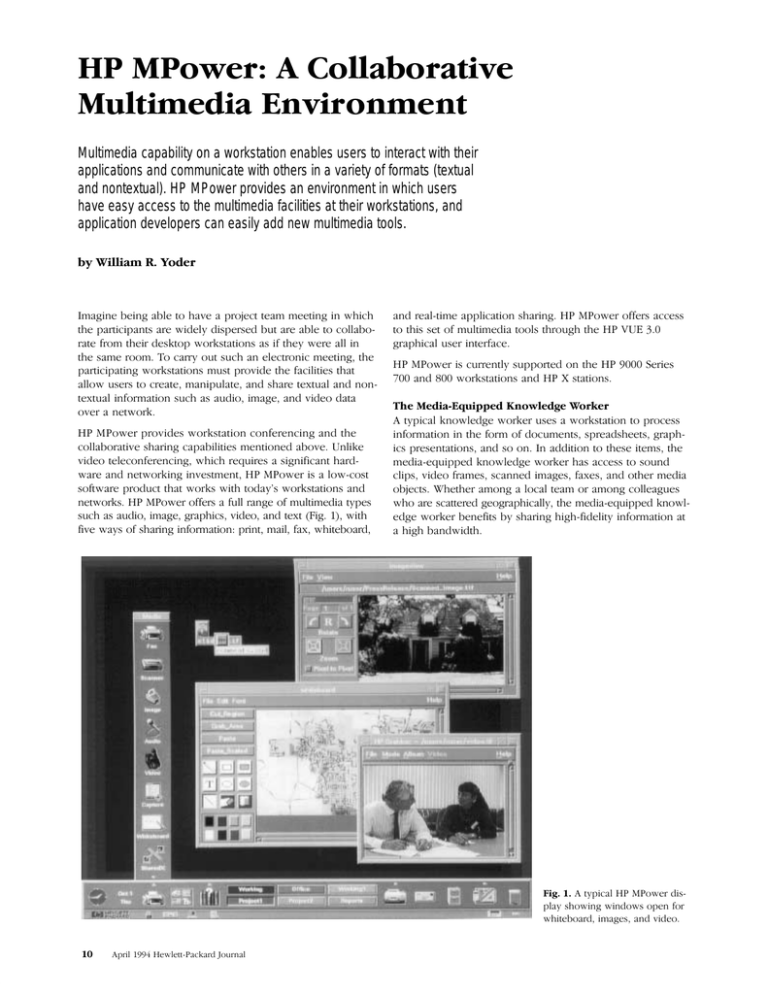
$ !#
"! # !
Multimedia capability on a workstation enables users to interact with their
applications and communicate with others in a variety of formats (textual
and nontextual). HP MPower provides an environment in which users
have easy access to the multimedia facilities at their workstations, and
application developers can easily add new multimedia tools.
% )#%*! !%*# (! 0+ $2! ,.+&!0 0!) )!!0%*# %* 3$%$
0$! ,.0%%,*0/ .! 3% !(5 %/,!./! 10 .! (! 0+ +((+6
.0! ".+) 0$!%. !/'0+, 3+.'/00%+*/ / %" 0$!5 3!.! (( %*
0$! /)! .++) + ..5 +10 /1$ * !(!0.+*% )!!0%*# 0$!
,.0%%,0%*# 3+.'/00%+*/ )1/0 ,.+2% ! 0$! "%(%0%!/ 0$0
((+3 1/!./ 0+ .!0! )*%,1(0! * /$.! 0!401( * *+*6
0!401( %*"+.)0%+* /1$ / 1 %+ %)#! * 2% !+ 0
+2!. *!03+.'
+3!. ,.+2% !/ 3+.'/00%+* +*"!.!*%*# * 0$!
+((+.0%2! /$.%*# ,%(%0%!/ )!*0%+*! +2! *(%'!
2% !+ 0!(!+*"!.!*%*# 3$%$ .!-1%.!/ /%#*%"%*0 $. 6
3.! * *!03+.'%*# %*2!/0)!*0 +3!. %/ (+36+/0
/+"03.! ,.+ 10 0$0 3+.'/ 3%0$ 0+ 5/ 3+.'/00%+*/ *
*!03+.'/ +3!. +""!./ "1(( .*#! +" )1(0%)! % 05,!/
/1$ / 1 %+ %)#! #.,$%/ 2% !+ * 0!40 %# 3%0$
"%2! 35/ +" /$.%*# %*"+.)0%+* ,.%*0 )%( "4 3$%0!+. * .!(60%)! ,,(%0%+* /$.%*# +3!. +""!./ !//
0+ 0$%/ /!0 +" )1(0%)! % 0++(/ 0$.+1#$ 0$! #.,$%( 1/!. %*0!."!
+3!. %/ 1..!*0(5 /1,,+.0! +* 0$! !.%!/
* 3+.'/00%+*/ * /00%+*/
&" $ 05,%( '*+3(! #! 3+.'!. 1/!/ 3+.'/00%+* 0+ ,.+!//
%*"+.)0%+* %* 0$! "+.) +" +1)!*0/ /,.! /$!!0/ #.,$6
%/ ,.!/!*00%+*/ * /+ +* * %0%+* 0+ 0$!/! %0!)/ 0$!
)! %6!-1%,,! '*+3(! #! 3+.'!. $/ !// 0+ /+1*
(%,/ 2% !+ ".)!/ /**! %)#!/ "4!/ * +0$!. )! %
+&!0/ $!0$!. )+*# (+( 0!) +. )+*# +((!#1!/
3$+ .! /00!.! #!+#.,$%((5 0$! )! %6!-1%,,! '*+3(6
! #! 3+.'!. !*!"%0/ 5 /$.%*# $%#$6"% !(%05 %*"+.)0%+* 0
$%#$ * 3% 0$
05,%( +3!. %/6
,(5 /$+3%*# 3%* +3/ +,!* "+.
3$%0!+. %)#!/ * 2% !+
,.%( !3(!006'. +1.*(
Send and Receive Faxes
Scan Monochrome and Color Images
View Xwd, Xbm, TIFF, GIF, Starbase,
and JPEG Images
Multimedia mail composing.
Play, Record, and Edit Audio
Workstations and PCs capable of providing multimedia acĆ
cess have until recently existed as islands of technology,
only good for standalone applications. A developer logs into
such a workstation and creates, say, a training module that
end users can access only at the isolated workstation. By
combining the power of media technology with networked
systems running the HPĆUX* operating system, HP MPower
enables users to collaborate effectively via a workstation
medium.
View Video in a Window from a Variety of
Video Sources and Capture Video Frames
Capture Window Contents
For example, suppose Margaret wants to send her colleagues
a document consisting of text, a scanned image of a competĆ
itor's magazine ad, and a voice clip commenting on the arĆ
ticle. She presses the mail button on the HP VUE front panel
shown in Fig. 1 to compose the mail message shown in Fig.
2, presses the scanner button on her HP MPower media
panel to scan in the ad, and then presses the audio button to
record her comments. Finally, she drags and drops the
scanned image and voice clip into her mail message and
sends it on its way.
As another example of using this mediaĆequipped workĆ
station, consider Jeffrey who wants to work on a CAD drawĆ
ing with his colleagues in Colorado and Washington. From
the HP VUE file manager, he drops the drawing into a whiteĆ
board window on his workstation, calls his colleagues on
the telephone, and uses the whiteboard window to interact
and collaborate with his colleagues. The whiteboard and the
software for sharing windows are discussed in the article on
page 23.
•
•
•
•
•
•
•
•
•
•
On a fullyĆequipped HP MPowerĆenabled workstation the
following services are available to the user:
Faxing
Online Documentation
Scanning
Image Viewing
Audio Recording and Playback
VideoĆinĆaĆWindow
Window Capture
Whiteboard Collaboration
Application Sharing
Color Graphics and PostScript Printing.
Many of the services listed above are accessible from the HP
MPower media panel shown in Fig. 3. Some of the other HP
MPower features accessible from the front panel include:
Import, Share, and Annotate Images
Share Application Windows
HP MPower media panel.
• Audio control for adjusting global audio output devices
• Help control for accessing systemĆwide online documentation
• Print control for printing text and graphics, managing print
requests, and administering printers
• Mail control for reading and composing plain text and mediaĆ
embedded mail messages.
•
•
•
•
•
Hardware Components. The basic HP MPower workstation
consists of a highĆresolution display, a keyboard, and a
mouse. For a fullyĆequipped HP MPower multimedia
workstation the other hardware components include:
BuiltĆin 8Ćbit or 16Ćbit audio with speaker or plugĆin headset
External scanner with SCSI interface
External fax modem (or modems) with serial interface
EISAĆbased video card
A variety of serial and parallel printers.
Software Components. HP MPower software consists of a
number of tightly integrated media tools coupled to the HP
VUE 3.0 user environment with interprocess communication
mechanisms for distributed processing. HP VUE 3.0 and HP
MPower are peers in the software hierarchy (see Fig. 4).
When the user selects an HP MPower media object (e.g.,
audio file) from the HP VUE 3.0 display, HP VUE hands conĆ
trol over to HP MPower to take the appropriate action on
the object.
April 1994 HewlettĆPackard Journal
HP MPower
Important HP MPower runĆtime libraries include the image
and audio libraries, which are described in the articles on
pages 37 and 62, respectively.
HP VUE 3.0
OSF/Motif Widgets
X Window System
Operating System and Network Software
Hardware Platform
The software hierarchical relationship between HP VUE 3.0
and HP MPower. HP VUE 3.0 provides user interface and desktop
services for the look and style of HP MPower media objects, and
HP MPower provides the actions associated with a particular media
object.
•
•
•
•
From a user's point of view, the HP MPower workstation
consists of an integrated set of tools and their associated
media objects. HP MPower provides facilities that enable the
user to:
Create media objects like a video frame sequence
Browse objects such as an incoming fax
Edit objects such as an audio track
Share objects such as a workstation window.
The appearance and behavior of HP MPower are derived
from the OSF/Motif style guide and from the HP VUE
desktop. For example:
• Users can doubleĆclick to invoke actions, as in playing an
A typical media tool consists of an OSF/MotifĆbased client
audio file
application, its runĆtime libraries, a backend server process, • Users can drag and drop media objects on HP MPower
and the appropriate device drivers (see Fig. 5). At the lowest
tools, as in dragging and dropping an image file on the fax
level, the device drivers control the hardware. For example,
composer.
the VideoLive card uses an XĆserver extension to access the
HP MPower tools are mouseĆdriven with pushbuttons,
frame buffer. This XĆserver extension enables direct hardĆ
pullĆdown menus, and dialog boxes.
ware access to the frame buffer, so that the VideoLive client
can manipulate 24Ćbit 640ĆbyĆ480Ćpixel images within the
context of an 8Ćbit root window. Media server components
are described in more detail later in this article, and the
VideoLive card is described in the article on page 68.
HP MPower Media Tool
(e.g., Audio, Printer,
Fax, etc.)
HP MPower
Client
Run-Time
Libraries
Interprocess
Communication
Module
LAN
Media Server
Process
HP MPower
Server
Device
Drivers
Media
Hardware
The architecture for a distributed multimedia application.
The HP VUE 3.0 interface is described on page 20.
The fileĆtyping mechanism used by HP VUE is extended to
media objects. For example, PostScript files are denoted by a
.ps suffix appended to the base file name (e.g., Article.ps). The
HP MPower media tools such as the audio editor ensure that
files are created with the appropriate suffix.
Each media object has certain allowable actions or methods.
For example, for audio files appropriate actions include Play,
Edit, and Mail, and for image files appropriate actions include
View, Print, Mail, and Fax. Table I lists the objects and actions
supported in HP MPower 1.0. These HP MPower actions
extend the predefined HP VUE 3.0 objects and actions.
Extensive online documentation is provided with the HP
MPower system. Built on the HP VUE 3.0 help system, HP
MPower online documentation includes component level
documentation (e.g., help on the fax composer) and system
level documentation (e.g., the Welcome to HP MPower"
chapter).
Top level indexes provide users with easy access to all the
help volumes on their system. The many hyperlinks† among
topics allow users to browse hundreds of pages of taskĆ
oriented and reference material, which may or may not be
related to the task they are performing. Another type of help
called item help enables users to find answers as they use the
media tools in the context of the task they are performing.
With the exception of a minimal set of introductory online
documentation, all help text is installed on the HP MPower
server to conserve client disk space. More about HP MPower
help is covered in the articles on pages 79 and 90.
† Hyperlinks are navigation pointers to related pieces of information. The online help article on
page 90 provides more information about hyperlinks.
April 1994 HewlettĆPackard Journal
Client
Table I
HP MPower Objects and Actions
Object
File
Suffix
Appropriate Actions in HP MPower
"
.au
6*&8* ).8 &.0 0&=
%!
.snd
6*&8* ).8 &.0 0&=
$#
.wav
6*&8* ).8 &.0 0&=
.l16
6*&8* ).8 &.0 0&=
.l8
6*&8* ).8 &.0 0&=
3
.lo8
6*&8* ).8 &.0 0&=
.al
6*&8* ).8 &.0 0&=
"
.u
6*&8* ).8 &.0 0&=
.ps
#.*; 6.28 &.0 &<
.eps
#.*; 6.28 &.0 &<
!
.tif, .tiff
#.*; 6.28 6*&8* &.0 &<
.gif
#.*; 6.28 &.0 &<
.jpg, .jpeg
#.*; 6.28 6*&8* &.0 &<
.bmf
#.*; 6.28 &.0 &<
.xbm, .bm
#.*; 6.28 6*&8* ).8 &.0 &<
.xpm, .pm
#.*; 6.28 6*&8* ).8 &.0 &<
%$
.xwd, .wd
#.*; 6.28 6*&8* &.0 &<
.mim
#.*; 6.28 6*&8* ).8 &.0 &<
"2/23;2
.unk
6*&8* &.0
&8&!*<8
&2=
#.*; 6.28 6*&8* ).8 &.0 &<
1
3;*6 .7 7-.44*) .2 & (0.*287*6:*6 (32+.,96&8.32
&003;.2, &440.(&8.327 &2) )&8& 83 '* ).786.'98*) &(6377 &
2*8;36/*) (31498.2, *2:.6321*28 2 & (0.*287*6:*6 &6(-.?
8*(896* 463,6&17 &2) )&8& &6* 740.8 &(6377 8-* 2*8;36/ &(?
(36).2, 83 *&(- 1&(-.2*7 (&4&'.0.8.*7 !-* 8*61 7*6:*6 6*+*67
83 & 463,6&1 3++*6.2, & 7*6:.(* 79(- &7 +&<.2, 36 46.28.2,
!-* 8*61 (0.*28 6*+*67 83 & 463,6&1 6*59*78.2, & 7*6:.(*
79(- &7 8-* +&< (31437*6 36 8-* -&6*)6.28 (0.*28
2 83)&=7 (0.*287*6:*6 ;360) 1&2= 7*6:.(*7 &6* 8=4.(&00=
(32(*286&8*) 32 & 43;*6+90 (*286&0 7=78*1 ;-.(- .7 8*61*)
& 7*6:*6 7=78*1 36 *<&140* 8-* 3;*6 7*6:*6 3++*67
'9.08?.2 +&< 1&.0 +328 -*04 46.28 &2) #" 7*6:.(*7 !-*
+92(8.32&0.8= &:&.0&'0* 03(&00= 32 8-* 97*67 )*7/834 .7 (30?
0*(8*) 32 ;-&8 ;* (&00 8-* 3;*6 (0.*28
•
•
•
•
Client
):&28&,*7 3+ 8-* 3;*6 (0.*287*6:*6 &6(-.8*(896*
.2(09)*
.786.'98*) 463(*77.2,
&<.191 4*6+361&2(* 1*&796*) '= .28*6&(8.:* 6*74327*
8.1*7 &2) 03&) '&0&2(.2,
.2.191 (378?4*6?7*&8 6*&0.>*) '= &2) ).7/ 7&:.2,7
(&0&'.0.8= .2 8-&8 ;-*2 2*; (0.*287 &6* &))*) 8-* 7=78*1
&)1.2.786&836 (&2 *.8-*6 &)) 2*; 7*6:*67 36 7.140= &)) &2) ).7/ 83 *<.78.2, 7*6:*67
2
LAN
2
1
FAX
Modem
HP MPower
Server
Printers
1
1
FAX
Modem
HP MPower
Server
LAN
1
Client
Client
&<.2, & )3(91*28 '*8;**2 8;3 (0.*287 (322*(8*) 83 ).++*6*28
3;*6 7*6:*67
& (0.*28 (&2 7*2) & )3(91*28 83 &2 3;*6 7*6:*6 463?
:.)*) .8 3++*67 46.28 7*6:.(*7 83 '* 46.28*) 32 & 74*(.+.(
46.28*6 .2 ., !=4.(&00= &2 3;*6 7*6:*6 463?
:.)*7 +&< 46.28*6 +328 320.2* -*04 &2) 97*6 .28*6+&(* 7*6?
:.(*7 !-* 3;*6 (0.*28 463:.)*7 03(&0 .1&,* 463(*77?
.2, &9).3 :.)*3 &2) ).740&= 7*6:.(*7 440.(&8.327 79(- &7
746*&)7-**87 (&2 692 32 8-* 7*6:*6 32 8-* (0.*28 36 32
)*).(&8*) &440.(&8.32 7*6:*67
3;*6 7*6:.(*7 (&2 '* 740.8 &132, & :&6.*8= 3+ 1&?
(-.2*7 .2 *<86*1*0= +0*<.'0* (32+.,96&8.327 36 *<&140*
-&6*)6.28 7*6:*67 &6* .278&00*) 32 ;-&8*:*6 1&(-.2*7
-&:* 46.28*67 4-=7.(&00= (322*(8*) 8-* +&< 7*6:*6 (&2 692
32 & 1&(-.2* ).++*6*28 +631 8-* 3;*6 7*6:*6 &2)
8-*6* (&2 '* 8;3 36 136* #" 7*6:*67 463:.).2, 03,.2
+.0* &2) ;.2)3; 1&2&,*1*28 7*6:.(*7 +36 & 0&6,* ,6394 3+
97*67 3;*:*6 .2 &66&2,.2, 7*6:.(*7 .2 79(- & 1&22*6 &2
*<86& '96)*2 .7 498 32 8-* 7=78*1 .278&00*6 &2) 2*8;36/
&)1.2.786&836
36 7.140.(.8= 8-* 3;*6 7*6:*6 '= )*+&908 6927 &00 8-*
3;*6 7*6:.(*7 !-* 3;*6 (0.*28 32 8-* 97*67
)*7/834 6927 ;-&8*:*6 463)9(8.:.8= 1908.1*).& 36 97*6
.28*6+&(* &440.(&8.327 .8 (&2 3++03&) +631 8-* 3;*6
7*6:*6
3;*6 7*6:*6 463(*77*7 .2(09)* 8-* )*:.(* )6.:*67 &2)
8-* .28*6463(*77 (31192.(&8.32 73+8;&6* 7-3;2 .2 ., !-* 7*6:*6 463(*77*7 .2 8-* 3;*6 2*8;36/ .2(09)*
., 7-3;7 & 8=4.(&0 3;*6 (0.*287*6:*6 (32+.,96&8.32
• 2 % ).740&= 7*6:*6 ;.8- -&6*)% &2) :.)*3
2 8-.7 (32+.,96&8.32 & (0.*28 (&2 +&< & )3(91*28 :.& &2 *<8*27.327
3;*6 7*6:*6 83 &238-*6 (0.*28 7** .2 ., ./*;.7*
46.0 *;0*88?&(/&6) 3962&0
• An audio server that manages local audio hardware
• A font server that manages the fonts on the HP MPower
server
• A fax server that manages local fax modems
• A print server that manages local printers.
These server processes enable client applications to access a
serially reusable resource attached to a given host. The font
server enables the HP MPower server to service font requests
from all applications, affording significant disk savings. The
fax server handles file conversions (e.g., converting from
PostScript to faxĆfile format), call routing, administrative
databases, and incoming and outgoing telephone connecĆ
tions. The print server employs a variety of filters to convert
popular imaging formats to a given printer's native language.
Descriptions of the audio, fax, and print server processes are
covered in the articles on pages 62, 53, and 44, respectively.
HP SharedX, which is a tool for sharing windows, is described
in the article on page 23.
HP MPower employs a variety of interprocess communicaĆ
tion mechanisms to enable its asynchronous, distributed proĆ
cesses to communicate and cooperate. UNIX* domain and
internet sockets provide most of the substrate, enabling reĆ
mote procedure calls and eventĆdriven protocols. Helper
processes include a remote invocation daemon for launching
distributed applications, a broadcast message server for passĆ
ing simple strings, a location broker daemon for establishing
1
Fax Server
PostScript Viewer
Online Help Files
HP SharedPrint Server
2
HP VUE
Icon Images
Fonts and Font Server
Mail Viewer, Composer, and Server
Multimedia File Converter
3
HP VUE
File
Manager
HP MPower
Fax
Composer
Run-Time
Library
Run-Time
Library
Drag
Initiated
Broadcast
Message
Server
Drop
Received
The broadcast message server enables the fax composer to
accept a dropped file from the HP VUE 3.0 file manager.
connections, and other standard UNIX services (X server,
name server, remote print daemon, NFSĆmount daemon, and
a mail transport mechanism).
For example, in extending the HP VUE 3.0 drag and drop
mechanism to the HP MPower tools, the broadcast message
server (BMS) provides the communication link (see Fig. 7).
HP MPower provides four preconfigured desktop clients as
shown in Fig. 8. For each configuration, Fig. 8 indicates the
approximate share of the HP MPower processing load that
HP MPower Server
HP MPower
Miniclient
LAN
HP MPower Services = 1 and 2
X11R5 Server with Video and HP SharedX Extensions*
Fax Composer and Browser
Scanner
Image Viewer
Audio Editor
Audio Server
Whiteboard Client
HP SharedPrint Clients
HP SharedX Client
(c)
• 25% Local Processing
• HP MPower Services = 3
HP MPower Server
HP MPower
Maxiclient
* This is the only component on an X station configuration.
LAN
(a)
HP MPower Services = 1
(d)
HP MPower Server
• 75% Local Processing
• HP MPower Services
2 and 3
HP MPower Client/Server Configuration
X Station
X
LAN
HP MPower Services = 1 , 2 , and 3
(b)
• X11R5 Display Driver
• 0% Local Application
Processing
(e)
• 100% Local Processing
• HP MPower Services 1 , 2 , and 3
Different desktop configurations provided with HP MPower. (a) HP MPower services provided by clients and servers. (b) X station
configuration. (c) Miniclient configuration. (d) Maxiclient configuration, (e) ClientĆonĆserver configuration.
April 1994 HewlettĆPackard Journal
occurs locally on the desktop client before any other appliĆ
cations are started. Fig. 8a shows the HP MPower services
distributed among the configurations shown in Figs. 8b to 8e.
Because of its complex interprocess interactions and client/
server architecture, HP MPower depends heavily on the
functionality of the HPĆUX operating system. For example,
HPĆUX scripts are used to customize HP MPower during
initial installation when the HP Instant Ignition†† process is
running. Scripts are also used to add, delete, and reconfigure
HP MPower clients.
X Station Configuration. In the X station configuration the user
runs HP VUE 3.0 and the media services totally from the HP
MPower server (Fig. 8b). There is no local processing, other
than the display server portion of the X11R5 window display
system.† HP 9000 Series 300 and 400 workstations and X
stations and workstations from other vendors can function as
HP MPower X stations. These stations will run the HP
MPower software entirely on the HP MPower server (includĆ
ing the client services), but can run other applications locally
on the workstation.
•
For more about X stations (or X terminals) see X Stations in
•
HP MPower" on page 16.
Note that the media tool software architecture shown in Fig.
5 is not applicable to the X station desktop configuration
because with the exception of the display and audio driver
software all software runs on the HP MPower server.
Miniclient Configuration. On an HP MPower miniclient most
media services, such as audio and imaging, run locally (Fig.
8c). The user's HP VUE session, including the file manager
and the window manager, runs on the HP MPower server.
The miniclient configuration takes advantage of local HPĆPA
RISC processing power for imaging operations, such as
rotation, scaling, and contrast.
•
•
•
•
•
Two of the most important scripts, which are run at instant
ignition boot time, are responsible for setting up the HP
MPower server and HP MPower clients. The server configuĆ
ration script (setup_server) performs the following functions of
the server system:
Starts the network file system (NFS) for remote file access
Starts the NFS automounter service to provide transparent
access to remote file systems
Starts the network computing system (NCS) to support
remote printing, faxing, and audio
Starts the X11 font server so that HP MPower clients can
obtain their fonts from the HP MPower server system
Starts the sendmail daemon so that users can send and
receive multimedia mail.
The setup_client configuration script, which runs on the HP
MPower client, performs the following functions:
Enables NFS and automounter
Sets up links between the client and server for the local
client file system
Establishes the fax, HP SharedPrint, and HP VUE
connections to the HP MPower server
Enables the drag and drop capability between server and
client.
•
Maxiclient Configuration. On an HP MPower maxiclient the HP
•
VUE user interface and most media services can be run loĆ
cally (Fig. 8d). The advantage here is that the dependence
on the HP MPower server for the desktop user interface is
The system administrator can add or remove other clients at
removed.
any time by running a simple admin_server script on the HP
MPower server.
Client-on-Server Configuration. This configuration uses a fully
loaded workstation, running both server and client HP
MPower software (Fig. 8e). Essentially, it offers standalone
At later system boots (after the initial installation described
media services suitable for both networked and nonnetĆ
above), the /etc/src.sh script sets certain key global environĆ
worked environments.
ment variables, such as the HP VUE server. On the HP
This configuration is easiest to configure and administer, but
MPower server, the /etc/rc file starts the fax server and the
it is the least costĆeffective solution. Also, it is limited to
font server processes. Other bootĆtime scripts start the NFS,
computers that support bitmap displays.
automount, and HP VUE login processes.
To provide a consistent environment for users whose data
files reside on one machine and applications on another, HP
MPower implements a network home environment. This
environment provides the user with a view of files that is
consistent across all machines in the HP MPower network.
The user sees the same colors, fonts, home directory, and so
on regardless of the HP MPower client or X terminal on
which a session is started.
To set up the home environment, system administrators have
three options for locating users' personal data (i.e., $HOME
directories):
• Leave the $HOME directory on the user's desktop workstation
• Place the $HOME directory on the HP MPower server
• Place the $HOME directory on an alternate file server.
When a the user logs in through the graphical HP MPower
welcome screen, other variables such as the user's audio
host, help path, and network home are established.
Because of the number of software components and hardĆ
ware configurations, testing HP MPower was a daunting
task. We concentrated on the configurations that would be
most popular, as directed by our product marketing team,
with particular emphasis on the HP 9000 Models 712 and
715 machines configured as standalone desktop clients. In
the course of the project, we used more than 20 integration
and test machines internally to verify software installation
and configuration.
†† See “The HP Instant Ignition Program” on page 17.
† The new HP ENVIZEX X stations offer a local flexible disk drive, audio, printing, and scanning.
April 1994 HewlettĆPackard Journal
The X station (or X terminal) is a product optimized to run X Window System server
software. X stations were developed when the X Window System was established
as a standard distributed windowing system for the UNIX operating system. Three
major factors accelerated the acceptance of X stations in the market:
• Emergence of the client/server model of computing
• Dramatic increases in processor compute power
• Improvements in networking technology.
The X station is a network-based display device that uses X protocol over a local
area network (LAN) to communicate with the host. The programs specially written
for X (called clients) run on the host but display their output on the X station. X
stations are also able to run programs locally. The programs that run locally on the
X stations are referred to as local clients. There are three major classes of local
clients: local window managers, local terminal emulators, and local utilities.
X stations cannot operate without a host because they use the compute power,
memory, and disk space of the host machine.
X Stations versus Workstations
The X station is a complementary product to the workstation in that it offers the
look, feel, sound, and graphics performance of a workstation, but at a much lower
price. Typically, the X station costs about half what the comparable workstation
costs, while providing workstation-like graphics performance. X stations allow
multiple users to access the power of a modern workstation (host), help to make
better use of the compute power and disk space available on the network, and
simplify system administration. X stations are not suitable for two types of users:
• Power users that run simulation and modeling programs
• 3D graphics users.
The reasons X stations are less expensive than workstations include:
• They use a low-cost embedded graphic controller as CPU. A general-purpose
processor used in a workstation is much more expensive.
• They need much less memory to perform the same tasks since they have a compact, real-time, UNIX-system-like operating system that uses only a small fraction
of the DRAM required for a complete UNIX operating system.
• Most of their electronic circuitry is integrated into application-specific integrated
circuits (ASICs) to reduce cost even further.
• They use less power, making their power supplies less expensive.
• They do not have any hard disks.
Configuring X Stations in HP MPower
X stations support all HP MPower functionality with the exception of a live video
input. X stations are not true HP MPower clients. They require that both the HP
MPower server and client run on the host. The newly introduced HP ENVIZEX
stations support local audio, local scanner, local floppy diskette in DOS format,
and HP SharedX functionality as a sender and receiver. The following additions
are recommended to the .vueprofile file in a home directory for a user that uses an
X station and the HP MPower software.
# AUDIO and SCANNER variables are derived from DISPLAY variable to ensure
# that multiple X stations can support local audio and local
# scanning while running HP MPower software on the same host.
xterm_name=$(echo $DISPLAY | sed ’s;:.*;;’)
SCANNER=$xterm_name
export SCANNER
+( 7($0 3529,'(' $1 $/3+$ 5(/($6( 72 $ 6(/(&7 180%(5 2)
&86720(56 :+,&+ :$6 +$1'>'(/,9(5(' $1' ,167$//(' %< $ 683>
3257 *5283 )520 7+( )$&725< !( $/62 &5($7(' 7:2 6(3$5$7(
%(7$ 5(/($6(6 72 )/86+ 287 ,167$//$7,21 $1' &21),*85$7,21 352%>
/(06 25( 7+$1 ,17(51$/ 6,7(6 ,167$//(' ($5/< 9(56,216
2) 7+( 62)7:$5( 85 *2$/ :$6 72 0,1,0,=( 7+( $02817 2)
7,0( 5(48,5(' 72 ,167$// 025( 7+$1 %<7(6 2) 62)7:$5(
:2 86$%,/,7< 7(676 +(/3(' 6+$3( 7+( 86(5 ,17(5)$&( 2) 7+(
6<67(0 !( /($51(' ($5/< 7+$7 7+( 86(5 ,17(5)$&(6 2) 7+( ,1',>
9,'8$/ &20321(176 +$' 72 &+$1*( 72 ),7 7+( 29(5$// 86(5 ,1>
7(5$&7,21 :,7+ 7+( 6<67(0 25 (;$03/( $// &20321(176
$'237(' $ 81,)250 ),/( 6(/(&7,21 ',$/2* 72 (1$%/( 86(56 72
$&&(66 $1' 6$9( ),/(6 &216,67(17/<
6<67(0 $'0,1,675$7,21 :$/.7+528*+ 5(68/7(' ,1 ,167$//$7,21
$1' '2&80(17$7,21 $'-8670(176 3$57,&8/$5/< ,1 25*$1,=,1*
7+( 6<67(0 ,167$//$7,21 ,172 6(3$5$7( 352&('85(6 )25 ,167$17
,*1,7,21 $1' 121,167$17 ,*1,7,21 6<67(06 +( 35(5(/($6(
)(('%$&. (1$%/(' 86 72 &87 7+( ,167$//$7,21 7,0( )520 7:2
:((.6 $7 7+( 352-(&7 2876(7 72 7:2 '$<6 $7 $/3+$ 5(/($6(
72 7:2 +2856 )25 7+( ),1$/ 352'8&7
!( ',9,'(' 7(67,1* 5(63216,%,/,7< $021* 7+( &20321(17
2:1(56 62 7+$7 21( 7($0 7(67(' 7+( )$; ,0$*,1* $8',2 $1'
27+(5 0(',$ &20321(176 $127+(5 7($0 7(67(' 7+( +$5('" $1' :+,7(%2$5' &20321(176 $1' $ 7+,5' 7($0 &29>
(5(' 7+( 0$,/ '(6.723 ,17(*5$7,21 $1' 6<67(0 ,167$//$7,21
$5($6 !( 5(/,(' (;7(16,9(/< 21 $1 $8720$7(' '()(&7 75$&.,1*
6<67(0 )25 021,725,1* '()(&7 /(9(/6 $1' 5(62/87,21 5$7(6 21 $
:((./< %$6,6
!( 3(5)250(' $ /,0,7(' 6(7 2) &2'( ,163(&7,216 21 1(: $1'
&5,7,&$/ 02'8/(6 ($0 0(0%(56 63(17 0$1< +2856 7(67,1*
7+( &20321(176 $1' 6<67(0 ,17(5$&7,216 0$18$//< +(< +$9(
6,1&( 67$57(' :25. 72 $8720$7( $ 180%(5 2) 7+(6( 7(676
2:(5 +$6 $ ',$*1267,& )$&,/,7< &$//(' Dr_MPower :+,&+
&216,676 2) $ 9$5,(7< 2) 68%02'8/(6 7+$7 &+(&. '2=(16 2) .(<
6<67(0 $1' 3(5621$/ ),/(6 72 (1685( 7+$7 7+( 6<67(0 $1' 7+(
0(',$ 6(59,&(6 $5( 3523(5/< ,167$//(' $1' &21),*85('
Dr_MPower &$1 %( 581 21 (,7+(5 $ 6(59(5 25 $ &/,(17
6(56 &$1 581 Dr_MPower 6,03/< %< '28%/(>&/,&.,1* 7+( 722/6
,&21 ,1 7+( ),/( 0$1$*(5 722/%2; (( 7+( $57,&/( $%29( )25
025( $%287 7+,6 ',$*1267,&
AUDIO=$xterm_name:0
export AUDIO
#SPEAKER=INTERNAL
SPEAKER=EXTERNAL
export SPEAKER
1,7,$//< 285 675$7(*< :$6 72 6833257 $6 60$// $ 180%(5 2)
&21),*85$7,216 $6 3266,%/( $1' 72 ,1&5($6( 7+$7 180%(5 :,7+
($&+ 68%6(48(17 352'8&7 5(/($6( !( %(*$1 %< 3529,',1*
6833257 )25 7+( (5,(6 21/< !,7+ 2:(5 :(
(;3$1'(' 7+$7 %$6( 72 ,1&/8'( 7+( (5,(6 $6 2:(5
6(59(56 7+( (5,(6 $1' $6 2:(5 " 67$7,216 $1'
7+( 1(: #" " 67$7,216 $6 0(',$>(1$%/(' " 67$7,216
,0,/$5/< 285 ),567 5(/($6( :$6 1*/,6+ 21/< 2:(5 $''(' 6833257 )25 $3$1(6( $1' >%,7 &+$5$&7(5 6(76
# uncomment if there are no external speakers
# comment out if there are no external speakers
(6,'(6 :25.,1* 21 $ 7,*+7 6&+('8/( 620( 2) 7+( &+$//(1*(6
:( (1&2817(5(' :+,/( '(9(/23,1* 7+( ),567 2:(5
352'8&7 ,1&/8'('
(continued on page 18)
35,/ (:/(77>$&.$5' 2851$/
The HP Instant Ignition program is focused on increasing customer satisfaction by
delivering a complete, integrated, preconfigured system† that is ready to use. The
program has the following goals:
• Give the customer a positive “out of the box” experience (i.e., a positive first
impression of our system)
• Decrease the “time to productive use” of a system
• Decrease HP’s field and factory cost by using common tools and standardized
processes.
What Is an Instant Ignition System?
The HP Instant Ignition system is made up of the basic computer system hardware,
including a disk that is preloaded with an operating system, optional application
software, and system documentation.
some utilities to the target disk to prepare for phase two. The last thing to occur in
phase one is to reboot the customer’s system.
In phase two, the customer’s system boots from its own disk, the target disk created
above. If necessary, instead of booting to the login screen as expected, the system
runs the utilities downloaded in phase one to fetch additional software. This software
may come from a netdist server or from another system on the network. The system
will also configure its kernel, if necessary, based on the customer’s hardware and
optional software.
The last thing to occur during a CHAMP build is to remove the CHAMP utilities and
return the operating system to a pristine state. The system then shuts itself down
and is ready for the customer.
Design Considerations
In designing CHAMP, a number of requirements had to be met. Some of the key
design requirements were to:
• Preload HP 9000 Series 700 and Series 800 HP-UX operating systems
• Run from a command line, allowing existing manufacturing processes to invoke
CHAMP automatically
• Run on the customer’s hardware (This guarantees that the HP-UX kernel and the
Additionally, the first time the system is booted, the user is prompted to provide
recovery instructions are specific to the customer’s hardware.)
system parameters that cannot be predicted in the factory, such as networking
• Load application software that is delivered in a variety of formats (HP’s preferred
specifics. This method of configuring the system eliminates the need for a user to
method for packaging software is update format. The utility /etc/update is a standard
edit files manually.
part of the HP-UX operating system and is available to internal and external customers. CHAMP is flexible enough to load software in other formats, such as tar
The HP MPower team designed an extension to these system parameter prompts.
and cpio.)
The links between the client and server are established as the system is booted so
• Load software in sequence (This means that if application 1 must be loaded before
that HP MPower is fully functional the first time any user logs into the system.
application 2, CHAMP can accommodate this sequence.)
• Generate customized recovery instructions for each system. (These instructions
CHAMP
outline exactly how the system was created in manufacturing so that the customer
To preload the various operating systems and applications, the instant ignition
can recreate the original system in the event of a disk failure. These instructions
team developed a software tool called CHAMP (channel-reseller and manufacare online in a file, and a hard-copy version is added to the shipping boxes at the
turing process). CHAMP fits into an automated hardware manufacturing line at a
final stage of the manufacturing process.)
point where the CPU is assembled with a disk and diagnostics have successfully
completed. At this point, the customer’s disk is ready to be built using a two-phase
Other Uses for CHAMP
process.
It became evident that CHAMP had potential uses outside of HP’s manufacturing
process. For instance, resellers could be more effective in delivering HP Instant
First, the customer’s CPU boots from a dedicated manufacturing disk that contains
Ignition systems if they had access to CHAMP and if CHAMP was easy to use and
the CHAMP tool. CHAMP runs on the customer’s hardware and downloads the
maintain.
operating system to the customer’s disk or target disk. CHAMP then downloads
The HP Instant Ignition design team set out to make HP 9000 systems less intimidating to the user. The team designed a number of usability enhancements aimed
at addressing the program goals. For example, esoteric messages were removed
from the boot process. The team replaced other messages with a concise checklist that indicates passing or failing portions of the boot procedure (Fig. 1). Labels
on boxes were enhanced to make them more readable.
† Currently HP 9000 Series 700 and 800 machines.
HP-UX Start-up In Process
Initializing System
Starting Networking
Starting Diskless Cluster Client
Starting System Functions
Starting Auditing
Starting Diagnostics
Status
[ OK ]
[ OK ]
[ OK ]
[ OK ]
[ OK ]
[ OK ]
(a)
HP-UX Start-up In Process
Initializing System
Starting Networking
Starting Diskless Cluster Client
Starting System Functions
Starting Auditing
Starting Diagnostics
Status
[ OK ]
[ FAIL ]*
[ OK ]
[ OK ]
[ OK ]
[ OK ]
NOTE: An error has occurred!
Refer to the file /usr/adm/rc.log for more information.
Press [Return] to continue…
(b)
Fig. 1. An HP Instant Ignition boot checklist. (a) When things are OK. (b) When things are
not OK.
While flexibility is one of the outstanding features of the CHAMP tool, flexibility
does not always equate to ease of use. To enhance usability, a graphical user
interface was layered onto the basic CHAMP tool. With this interface, CHAMP is
very easy for the nonexpert, such as a reseller, to use to build preloaded systems
quickly.
CHAMP is also used by operating system and application developers internal to
HP. These developers can use CHAMP to build a test system for their development.
It takes about 30 minutes to create a new HP-UX system using CHAMP. This is
considerably faster than using CD-ROM media to build a new system. All HP teams
that develop pieces of the HP-UX operating systems and preloaded applications
are required to test their software on the base system built by CHAMP.
Conclusion
Customer acceptance and popularity of the HP Instant Ignition program continues
to grow. Customers like to receive their systems with preloaded software. Today
the HP Instant Ignition program is limited to preloading HP applications because of
internal issues related to selling and preloading third-party software.
Sue Magenis
Development Engineer
Open Systems Software Division
The need for installation and configuration diagnostics for user interface software
became apparent soon after the release of HP VUE 2.0. Because of the large
number of files associated with HP VUE and the dissemination of those files
across the file system, response center† engineers were spending a lot of time
telling customers about which files to check for known problems. An analysis of
call-in data from the Atlanta response center revealed that the amount of time
spent each quarter handling HP VUE configuration questions was rising rapidly.
As a result of this feedback, the technical training and support group in Corvallis
decided that a script or program could more efficiently wander the highways of the
file system and check on the existence, permissions, and ownership of most of the
files that HP VUE depended on. Key files, such as /usr/adm/inetd.sec, /etc/inittab, and
others could be searched with standard tools to determine if the attributes required
for certain entries were proper. The use of a script could reduce the amount of
time required to check basic configuration issues from hours or days to a matter of
a minutes. Thus, Dr_VUE (diagnose and report Visual User Environment problems)
was born.
Dr_MPower is a direct outgrowth of Dr_VUE. Dr_MPower consists of a collection of
diagnostic tools used to help debug installation and configuration problems in the
HP MPower environment. Since HP MPower combines several disparate applications, we decided to create a separate script to check each individual component.
This resulted in a total of 12 scripts: one each for 10 components of HP MPower, a
file that contains common functions used by each of the scripts, and a calling
script. The calling script is Dr_mpower, which does some checking of system functions and then calls each of the remaining scripts in turn. Since HP MPower makes
heavy use of the HP VUE environment, an action was defined to initiate Dr_MPower.
This action is located in one of the toolboxes available to all users. A simple
double-click on the Dr_MPower icon results in a new terminal window that displays
the information output by Dr_MPower. Each of the scripts called by Dr_MPower can
also be run individually to perform checking on the separate components of the HP
MPower environment.
A myriad of configuration issues exist in the HP MPower environment. Dr_MPower
certainly does not check each and every possible one, but rather looks at what we
hope to be the vast majority of them. Since the MPower environment consists of
servers, maxiclients (clients running HP VUE locally), miniclients (clients running
HP VUE on the server), and X terminals, the first thing that Dr_MPower needs to
determine is the type of system it is running on. When this has been accomplished, Dr_MPower will check items specific to that environment. For example,
there are differences between the client and the server in recommended kernel
parameters, as well as certain processes that run on the server and not on the
client. Another difference is the fact that the miniclient does not run HP VUE
† HP has several locations worldwide that are responsible for handling software or hardware
problems from customers who have purchased response-line support contracts. These
locations are called response centers.
locally, so the check_vue script that is called by Dr_MPower should not be run for that
platform.
The installation and configuration of HP MPower makes heavy use of scripts, and
since scripts fail occasionally, Dr_MPower attempts to verify that all the actions
performed in the various configuration scripts have been accomplished. An example is checking in the file /etc/netnfsrc to see if the parameters NFS_CLIENT,
NFS_SERVER, and START_MOUNTD were successfully set to one by the configuration scripts. Another example is checking to see that a line was added in /etc/rc to
start the font server and that the font server is currently running. Fig. 1 is a graphical
representation of the components checked by Dr_MPower.
Anytime Dr_MPower encounters something that appears to be in error, a message
is written that attempts to inform the user as to the severity of the problem with
either INFO, WARNING, or ERROR statements (similar to the feedback seen in an
update log). If possible, an appropriate course of action is also given. For example,
a check is made of the /etc/src.sh file to determine if the configuration script added
two entries specifying the HP MPower and HP VUE servers. The following code
performs this check and issues a WARNING statement if the installation script did
not add the entries in the /etc/src.sh file:
## look in /etc/src.sh to see if VUE_SERVER and MPOWER_SERVER were
## added
count=$(grep –e VUE_SERVER –e MPOWER_SERVER /etc/src.sh | wc –l)
[ $count –eq 2 ] ||
print “WARNING:The MPower installation script should have added
two entries to /etc/src.sh:
VUE_SERVER=$hostname; export VUE_SERVER
MPOWER_SERVER=$hostname; export MPOWER_SERVER
This does not appear to be the case. You should rerun the
/usr/MPowerServer/setup_server script or add these
lines yourself.”
This code performs the check and provides the user with two options to correct the
perceived problem: either manually add the entries or rerun the configuration script
that should have made the additions.
There are over 4000 lines of code in the various scripts that make up Dr_MPower.
Considering the positive feedback we have received from support partners concerning Dr_VUE, we are confident that the Dr_MPower scripts will significantly
reduce the time spent supporting customers with HP MPower problems.
John V. Peterson
Support Engineer
Workstation Group/Corvallis
• ",$/-%& ))6 0"-/1"! 1"*0 %" ,4"/ -/,'" 1
&*-)"*"+1"! 3/&"16 ,# #&)"816-&+$ *" %+&0*0 /+$&+$
1"* &+ )2!"! *"*"/0 #/,* /"$,+ 00 %20"110
#/,* --"+!&+$ #&)" +*" 02##&5"0 1, &+0-" 1&+$ #&)" ,+1"+10
)&#,/+& ,),/!, +! +! ""-&+$ 1%" )&+"0 ,# ,*8 • &3&+$ 4&1%&+ 4,/(011&,+ /"0,2/ "0 ,1&# --)& 1&,+0
*2+& 1&,+ ,-"+ +! "##& &"+1 %")-"! 20 2+!"/01+! 0,*"
/" .2&1" )/$" %20 /2++&+$ 3/&"16 ,# ,1&#80"!
,# 1%" /".2&/"*"+10 ,# !&01/&21"! 4,/( $/,2-0
--)& 1&,+0 +! *6/&! ,# 0"/3"/ +! %")-"/ -/, "00"0 ,+
• +1"$/1&+$ !&0-/1" ,*-,+"+10 +&1&))6 1"* *"*"/0
)&*&1"!8*"*,/6 0601"*0 #,/ "! 20 1, !,-1 )&"+180"/3"/
!"0&$+"! 1%"&/ -/,!2 10 02 % 0 #5 +! 4%&1",/! 0
/ %&1" 12/"
01+!),+" --)& 1&,+0 %&"3&+$ ,**,+ ),,( +! #"") • /$" *"!& ,'" 10 "!& ,'" 10 /" 6 +12/" )/$" ,/
&+3,)3"! %+$&+$ -/10 ,# ,2/ ,4"/ 020601"*0 02 %
"5*-)" 0,2+! )&- + ,01 61"0 -"/ 0" ,+! +!
0 &+1"/-/, "00 ,**2+& 1&,+ *" %+&0*0 & ,+ 3&02)0
" % 3&!", #/*" + ,01 )*,01 *"$61" " 20" ,+)&+" %")- +! !&),$ ,5 "%3&,/
+2*"/ ,# ,*-/"00"! #&)" #,/*10 1, (""- #&)" 0&7"0 1, • + ,/-,/1&+$ ,**,+ #&)"816-&+$ *" %+&0* %" 8
*&+&*2* 02 % 0 1%" #&)" #,/*1 #,/ 3&!", &*$"0
#&)" 0601"* &0 !"0&$+"! 1, 1/"1 )) #&)"0 0&*-)6 0 $0 ,#
,/12+1")6 1%" -/, "00&+$ -,4"/ ,# 1%" 880"!
61"0 &1%&+ $/-%& ) 20"/ "+3&/,+*"+1 &1 &0 +" "00/6 1,
4,/(011&,+0 *("0 1%" ,*-/"00&,+ +! !" ,*-/"00&,+ ,#
(+,4 #&)" 16-"0 1, !"1"/*&+" 1%" --/,-/&1" 1&,+0 #,/ *"!& ,'" 10 #&/)6 -&+)"00 -/, "00
$&3"+ ,'" 1 "$ *&) -/&+1 "!&1 #5 -)6 +! 3&"4 ,
• ,+#&$2/&+$ 1%" !&01/&21"! "+3&/,+*"+1 601"* !*&+&01/8
-/"0"/3" 1%" #&)" 16-"0 ,# ,4"/ *"!& ,'" 10 4"
1&,+ 2/!"+0 + $/,4 "5-,+"+1&))6 4%"+ 0"/3& "0 /"
-/&) "4)"118 (/! ,2/+)
check_fax
check_vue
check_scan
check_image
check_mail
check_audio
Dr_MPower
check_video
check_sprint
check_sharedX
Fig. 1. The HP MPower components checked
by Dr_MPower and the associated scripts
responsible for making the checks.
!)*(!+* &,( ),(# &)*) / &(!% !(#/ ()*(!*
+#* &%!+(*!&% - , (+ * &
!%)*##!% % $!%*!%!% &-( %&)
• !,!% !% * %*-&(" &$ &/) +)() ( $!#!( -!*
)"*&' &$'+*!% !% - ! $&)* & * !( ''#!*!&%) %
* ()! &% * !( #&# $ !% % * !( %,!(&%$%*
!) !)*(!+* (&)) $+#*!'# &)*) +)() % &$ !)&(!1
%* !% * %*-&(" %,!(&%$%* , *(! *& $"
!# )) ) *(%)'(%* ) '&))!# % *& !%,&" ''#!1
*!&%) &% * .'* &)*
&-( *$ -&+# #!" *& * %" * !%)*%* !%!*!&%
*$ * &(* &##!%) &#&(& % * .*( &$'+*(
%+*+(!% '(*!&% *$ * #$)&( )) +)**)
&( * !( #' !% #!,(!% * !) )*1*(" '(&+* *& $("*
%") *& (! !#)&% * &(,##!) $%+*+(!% &&(!%1
*&( &( .'!*!% * (#) % ) !''!% '(&)) +)( !%*( )!% *$ / ((/ * !) '(&1
,! !%,#+# #' !% )"*&' ,!)+# !%*(*!&% %")
*& %() # ((/ &-#% % !$ +% &( * !(
,#+*!&%) & * &-( #!%*)(,( ( !**+( %
)/)*$ $!%!)*(*!&% !%##/ )'!# * %") *& "&
!/" &( #&#!0!% * &-( '(&+* &( '%
HP-UX is based on and is compatible with UNIX System Laboratories’ UNIX* operating system.
It also complies with X/Open’s* XPG3, POSIX 1003.1 and SVID2 interface specifications.
UNIX is a registered trademark of UNIX System Laboratories Inc. in the U.S.A. and other countries.
X/Open is a trademark of X/Open Company Limited in the UK and other countries.
PostScript is a trademark of Adobe Systems Incorporated which may be registered in certain
jurisdictions.
OSF/Motif is a trademark of the Open Software Foundation in the U.S. and other countries.
'(!# -#**1"( &+(%#


